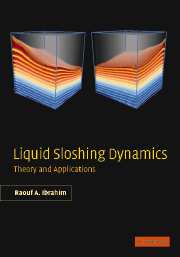Book contents
- Frontmatter
- Contents
- Foreword
- Acknowledgment
- Introduction
- Part I Linear sloshing dynamics
- Part II Nonlinear and parametric sloshing dynamics
- Part III Sloshing – structure interaction
- 8 Linear interaction with elastic containers
- 9 Nonlinear interaction under external and parametric excitations
- 10 Interaction with support structures and tuned sloshing absorbers
- Part IV Rotating fluid and low gravity sloshing
- References
- Index
9 - Nonlinear interaction under external and parametric excitations
from Part III - Sloshing – structure interaction
Published online by Cambridge University Press: 11 August 2009
- Frontmatter
- Contents
- Foreword
- Acknowledgment
- Introduction
- Part I Linear sloshing dynamics
- Part II Nonlinear and parametric sloshing dynamics
- Part III Sloshing – structure interaction
- 8 Linear interaction with elastic containers
- 9 Nonlinear interaction under external and parametric excitations
- 10 Interaction with support structures and tuned sloshing absorbers
- Part IV Rotating fluid and low gravity sloshing
- References
- Index
Summary
Introduction
The dynamic analysis of a cylindrical shell experiencing elastic deformation that is comparable to its wall thickness cannot be described within the framework of the linear theory. The same is applied if the liquid free-surface amplitude is relatively large. In both cases, nonlinear analysis should be carried out. The presence of nonlinearities may result in nonlinear resonance conditions that cause complex response characteristics. One of the main difficulties in nonlinear problems of shell–liquid systems is that the boundary conditions are essentially nonlinear. This is in addition to the fact that the strain state of an elastic shell and the shape of the liquid free surface are not known a priori. The treatment of the nonlinear interaction of a liquid–shell system is a nonclassical boundary-value problem and relies on mechanics of deformable solids, fluid dynamics, and nonlinear mechanics.
With reference to nonlinear vibrations of cylindrical shells in vacuo, the literature is very rich and reports some controversies regarding the influence of nonlinearities on the shell dynamic behavior. The main results have been reviewed by Vol'mir (1972, 1979), Leissa (1973), Evensen (1974), Kubenko, et al. (1984), Amiro and Prokopenko (1997), and Amabili, et al. (1998b). Some attempts have been made to reconcile the reported discrepancies (see, e.g., Dowell, 1998, Evensen, 1999, and Amabili, et al. 1999c). It is believed that Reissner (1955) made the first attempt to study the influence of large-amplitude vibration for simply supported shells.
- Type
- Chapter
- Information
- Liquid Sloshing DynamicsTheory and Applications, pp. 538 - 606Publisher: Cambridge University PressPrint publication year: 2005



